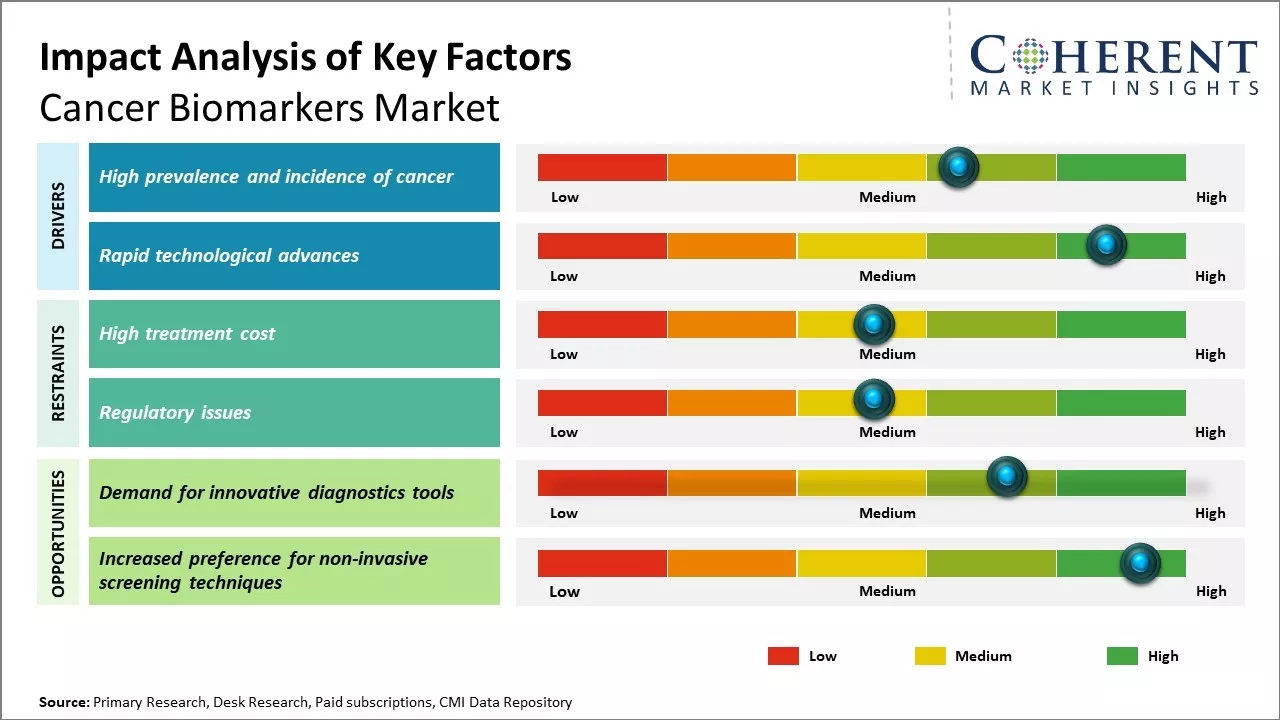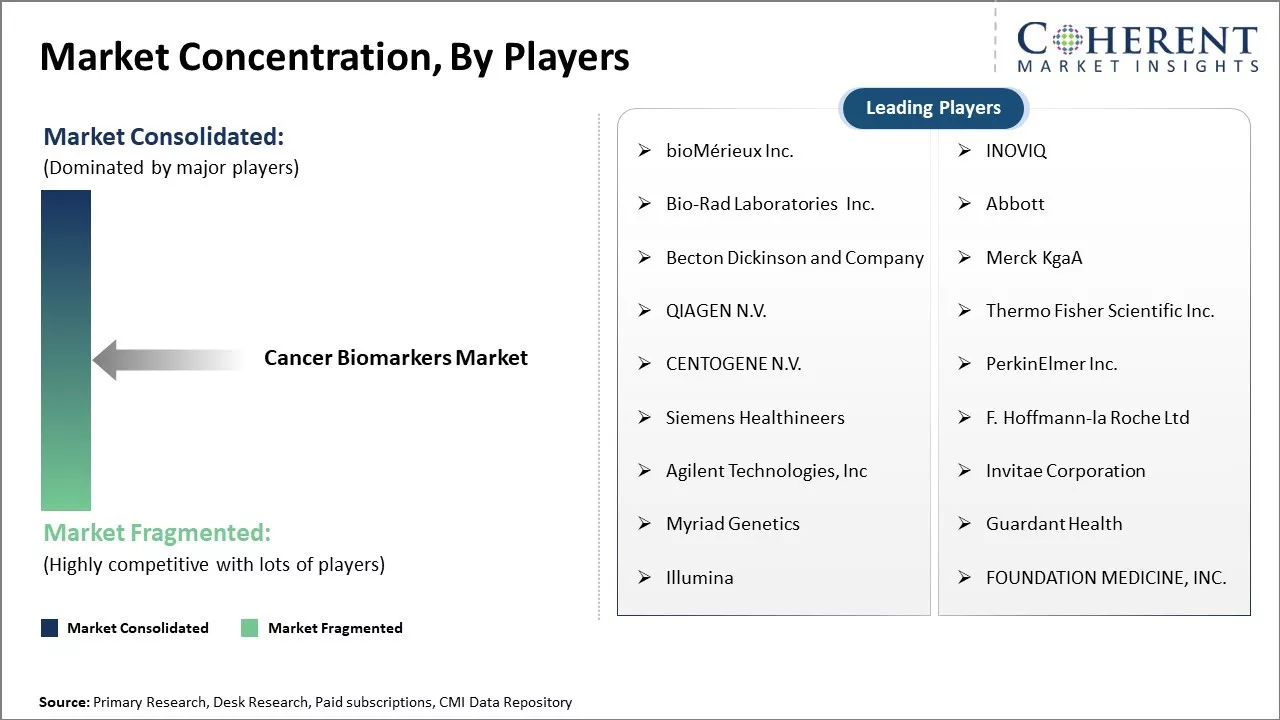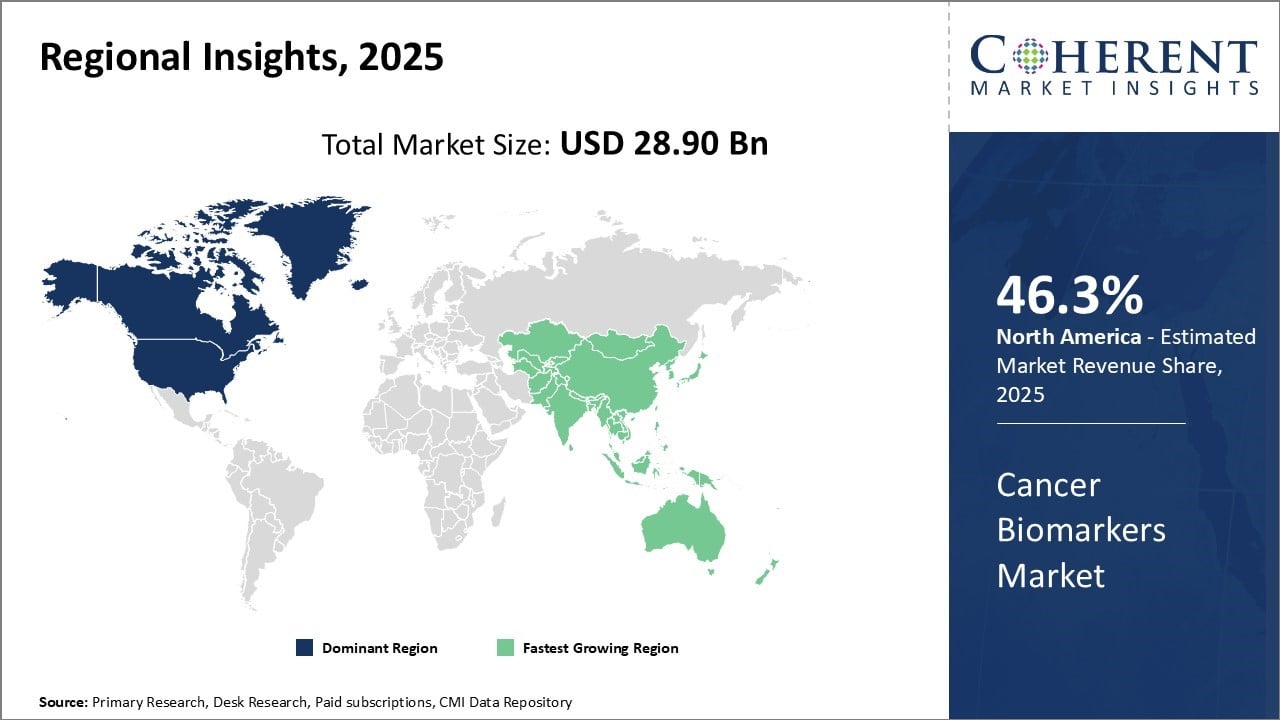
Global cancer biomarkers market size is estimated to be valued at USD 28.90 Bn in 2025 and is expected to reach USD 67.62 Bn by 2032, exhibiting a compound annual growth rate (CAGR) of 12.9% from 2025 to 2032.

To learn more about this report, Download Free Sample
Advancements in precision medicine and personalized cancer treatment boosts demand for cancer biomarkers. The ability of biomarkers to detect cancer at its earliest stages, guide therapeutic options, and monitor the effectiveness of treatment is boosting its adoption across the healthcare industry. Biomarker tools that improve diagnosis and help clinicians develop targeted therapies tailored to an individual patient's tumor characteristics are most widely used in clinical practice. This shift towards precision medicine and individualized care based on a patient's molecular profile is propelling the cancer biomarkers market growth.
|
Event |
Description and Impact |
|
AI and Machine Learning Revolution in Diagnostics |
|
|
Geopolitical Tensions and Trade Disruptions |
|
|
Personalized Medicine Healthcare Policy Shifts |
|
Uncover macros and micros vetted on 75+ parameters: Get instant access to report
Cancer biomarkers market demand is shaped by a stratified pricing structure influenced by biomarker type, test complexity, and regional reimbursement frameworks. Standard protein-based biomarker assays, widely utilized in the cancer biomarkers market for early screening and monitoring, are priced between approximately USD 100–400 per test as of early 2025. For instance, in Q1 2024, HER2 testing averaged USD 320/test in the USA, USD280/test in Germany, and USD150/test in India.
In Q2 2024, pricing in China dropped to USD130/test due to expanded domestic kit production, while Germany held steady near USD290/test. By March 2025, global pricing for mainstream assays such as PSA, CA-125, and CEA averaged ~USD310/test in the USA, ~USD145/test in China, and ~USD295/test in Germany.
Specialized genetic and liquid biopsy panels—such as NGS-based companion diagnostics or circulating tumor DNA tests—command a significant premium, typically ranging from USD1,200–5,000 per test, with proprietary panels from U.S. companies reaching up to USD4,500/test depending on complexity and coverage.
AI and automation are increasingly transforming cancer biomarker discovery, testing, and interpretation—mirroring their impact in other sectors like pectin production. Advanced AI‑driven assay platforms now use machine learning models and real‑time sensor data to optimize reaction conditions, enhancing test reliability while reducing time‑to‑result by up to 40%.
In clinical diagnostics, deep learning models analyze high‑dimensional genomic and proteomic datasets in liquid biopsies—automatically detecting patterns and anomalies beyond human capability, which boosts sensitivity and accuracy. Fully automated workflows, from sample prep to data reporting, reduce manual labor and inter‑laboratory variability, enabling standardized, high-throughput screening across centralized and decentralized labs.
By integrating AI‑based quality control—such as image-based anomaly detection in assay readouts—laboratories can flag inconsistent samples early, minimizing retests and improving assay throughput. Overall, AI automation in cancer biomarker testing streamlines workflows, accelerates innovation in multi‑marker panels, and enhances precision oncology by delivering faster, more reliable, and scalable diagnostic solutions.
Rising prevalence of cancer is expected to drive the market growth over the forecast period. Breast cancer is the second most common type of cancer in the U.S., after skin cancer. Breast cancer can occur both, in men and women. However, it is mostly found among females and the male occurrence of breast cancer is very rare. For instance, according to the data provided by the Breastcancer.org in March 2022, an estimated 287,850 new cases of invasive breast cancer were diagnosed in women in the U.S., along with 51,400 new cases of non-invasive (in situ) breast cancer in 2022.

To learn more about this report, Download Free Sample
Rising prevalence of cancer is expected to drive the market growth over the forecast period. Breast cancer is the second most common type of cancer in the U.S., after skin cancer. Breast cancer can occur both, in men and women. However, it is mostly found among females and the male occurrence of breast cancer is very rare. For instance, according to the data provided by the Breastcancer.org in March 2022, an estimated 287,850 new cases of invasive breast cancer were diagnosed in women in the U.S., along with 51,400 new cases of non-invasive (in situ) breast cancer in 2022.
Technology is revolutionizing the field of cancer research and precision oncology at a rapid pace. Advanced techniques like next generation sequencing, multiplex assays, machine learning and artificial intelligence are enabling discovery of novel biomarkers and robust biomarker panels. These breakthrough innovations allow detection of cancer mutations, gene fusions, copy number variations and biomolecules with higher sensitivity and specificity.
Development of techniques like liquid biopsy makes it possible to non-invasively monitor cancer evolution and response to treatment in real time by analyzing biomarkers in blood or other biofluids. At the same time, miniaturization and digitization is driving the development of portable, affordable detection platforms suitable for point-of-care application. This includes tools like smartphone-based readers and microfluidic chips.
Widespread adoption of such technologies in clinical practice would significantly improve accessibility of timely and repeated biomarker tests. Given the fast pace of scientific progress, many more innovative biomarkers and companion diagnostics are in product development pipeline.
The cancer biomarkers market forecast indicates that growth may be hindered by major factors such as high treatment costs and unfavorable reimbursement policies. For instance, according to the data updated by ClinicSpots, an online platform for users/patients to interact and discuss symptoms and cure for their ailment.
In June 2, 2022, on average, the cost of cancer treatment in India is around INR 500,000 (USD 6,437) with a minimum expense of INR 90,000 (USD 1,158) and a maximum cost of INR 2,750,000 (USD 35,403). Moreover, the cost varies in different countries and treatment of cancer in India costs 60-80% less than in countries like the U.S., the U.K., Singapore, and others.
As the population continues to age, projections indicate a substantial increase in cancer incidence rates, thereby generating a heightened demand for innovative diagnostic and monitoring tools in the healthcare sector. Personalized medicine and companion diagnostics are expanding the applications of biomarkers. Biopharma companies are increasingly collaborating with diagnostic firms to co-develop drugs and biomarkers. New technologies such as genomics and proteomics are enabling discovery of novel biomarkers from biofluids and tissues.
CA 125 segment is anticipated to hold 27.3% of the market share in 2025. HER2 protein overexpression or gene amplification is a key biomarker for breast cancer, detected in approximately 20% of breast cancer cases. The development of immunohistochemistry assays and in-situ hybridization tests has enabled accurate detection of HER2 status to determine treatment with HER2-targeted therapies such as trastuzumab.
Continuous technological improvements have made these diagnostic tests more robust and affordable. Inclusion of HER2 testing in breast cancer treatment guidelines globally has promoted its widespread usage.
Further clinical validations have expanded assessment of HER2 biomarkers beyond breast cancer to other tumor types such as gastric and colorectal cancers. Increased understanding of HER2's relevance in tumor biology and advances in companion diagnostics have consolidated its leadership position in the cancer biomarkers landscape.
Cancer type segment is sub-segmented into breast cancer, lung cancer, prostate cancer, kidney cancer, liver cancer, head & neck cancer, non-small cell lung cancer, and other cancers. The cancer biomarkers market outlook highlights the breast cancer segment as the largest contributor, projected to hold 29.3% of the market share by 2025.
Breast cancer is the most common cancer among women worldwide, with over 2 million new cases diagnosed each year. Extensive campaigns by women's health organizations have raised awareness about risks and importance of early detection. This has increased participation in mammography screening programs across populations.
Further, development of novel imaging technologies like tomosynthesis and contrast-enhanced spectral mammography have improved diagnostic capabilities of screening. Such screening enables detection of tumors at localized stages amenable to effective treatment and monitoring. This has boosted demand for diagnostic biomarkers to personalize therapeutic approaches in breast cancer management.
Clinical adoption of multi-parametric biomarker panels and liquid biopsy tests also allow non-invasive, longitudinal monitoring of patients. Collectively, these efforts in creating awareness and diagnostic advancements promote the dominance of breast cancer segment.
End User segment is sub-segmented into hospitals, specialty clinics, diagnostic laboratories, academic & research institutes, and others. Diagnostic laboratories contribute the highest share to the cancer biomarkers market value and are projected to hold 29.7% of the market share in 2025.
Diagnostic laboratories possess the necessary infrastructure, trained personnel and regulatory approvals to perform complex biomarker assays on a large scale. These work closely with pathologists to provide critical information for clinical decision making. Tests conducted by diagnostic labs are directly reimbursed under healthcare programs unlike those by other end users. This ensures a steady stream of revenue.
Diagnostic labs also have capabilities to develop and validate novel multiplex biomarker tests. Their expertise enables translation of research insights into clinically useful tools. Moreover, centralization of testing in large diagnostic laboratories offers advantages of standardized, high-quality results with faster turnaround times. This sustains their primacy in fulfilling the bulk of demand for cancer biomarkers from hospitals and physicians. Continuous technologization of labs will further expand their diagnostic portfolio and market share over time.

To learn more about this report, Download Free Sample
North America has established itself as the dominant region in the global cancer biomarkers market, with cancer biomarkers market prices supported by its anticipated 46.3% share of the market in 2025. The presence of leading biotechnology and pharmaceutical companies has propelled significant investments in cancer biomarker research and development activities.
Furthermore, the region has higher prevalence of cancer types such as lung, prostate and breast cancer as compared to other parts of the world. This has sustained demand for newer diagnostic and treatment methods, driving the uptake of cancer biomarkers. Regulatory approvals are also quicker in the U.S., allowing new biomarkers to be commercialized at a faster pace.
Asia Pacific has emerged as the fastest growing regional market for cancer biomarkers. The growth can be attributed to improving healthcare standards and increasing disposable income levels in major Asian countries. Governments are allocating higher budgets for modernization of healthcare facilities. This along with expanding medical insurance will enhance the affordability of high-end diagnostic technologies.
Moreover, countries like China and India, with their low-cost operations and large patient populations, have become key hubs for cancer biomarkers in clinical trials, attracting numerous global research firms to establish regional centers. The prevalence of certain cancers is rising due to environmental factors and changing lifestyle habits in Asia.
This growing cancer burden coupled with industry friendly business environment makes the region an attractive long-term investment destination for leading biomarker companies. Collaborations between international pharmaceutical players and domestic diagnostic labs are also propelling the adoption of advanced cancer screening approaches.
The U.S. leads within the region, contributing the bulk of this dominance thanks to higher cancer prevalence, rapid regulatory approvals, and concentration of major biotech and pharmaceutical firms driving R&D activity.
Europe ranks as the second-largest region for cancer biomarkers, supported by advanced diagnostics, high per-capita spending, and strict but established regulatory frameworks under IVDR.
| Report Coverage | Details | ||
|---|---|---|---|
| Base Year: | 2024 | Market Size in 2025: | USD 28.90 Bn |
| Historical Data for: | 2020 To 2024 | Forecast Period: | 2025 To 2032 |
| Forecast Period 2025 to 2032 CAGR: | 12.9% | 2032 Value Projection: | USD 67.62 Bn |
| Geographies covered: |
|
||
| Segments covered: |
|
||
| Companies covered: |
bioMérieux Inc., INOVIQ, Bio-Rad Laboratories Inc., Abbott, Becton Dickinson and Company, Merck KgaA, QIAGEN N.V., Thermo Fisher Scientific Inc., CENTOGENE N.V., PerkinElmer Inc., Siemens Healthineers, F. Hoffmann-la Roche Ltd, Agilent Technologies, Inc, Invitae Corporation, Myriad Genetics, Guardant Health, Illumina, FOUNDATION MEDICINE, INC. |
||
| Growth Drivers: |
|
||
| Restraints & Challenges: |
|
||
Uncover macros and micros vetted on 75+ parameters: Get instant access to report
*Definition: Global cancer biomarkers market involves the discovery, development, and commercialization of biomolecules found in blood, tissue, urine or other body fluids that can be indicators of normal biological processes, pathogenic processes, or pharmacological responses to therapeutic interventions for cancer. Cancer biomarkers are used for early detection of cancer, screening for cancer risk, deciding treatment options, monitoring treatment response, and recurrence of cancer after treatment. Global cancer biomarkers market offers tests for protein, genetic and epigenetic biomarkers to aid accurate diagnosis and effective treatment.
Share
Share
About Author
Komal Dighe is a Management Consultant with over 8 years of experience in market research and consulting. She excels in managing and delivering high-quality insights and solutions in Health-tech Consulting reports. Her expertise encompasses conducting both primary and secondary research, effectively addressing client requirements, and excelling in market estimation and forecast. Her comprehensive approach ensures that clients receive thorough and accurate analyses, enabling them to make informed decisions and capitalize on market opportunities.
Missing comfort of reading report in your local language? Find your preferred language :
Transform your Strategy with Exclusive Trending Reports :
Frequently Asked Questions
Joining thousands of companies around the world committed to making the Excellent Business Solutions.
View All Our Clients